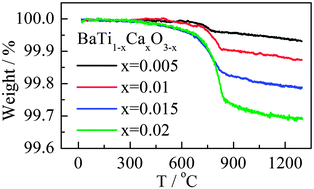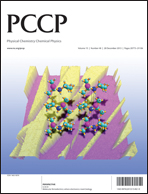Hole conductivity in oxygen-excess BaTi1−xCaxO3−x+δ
Abstract
BaTiO3 containing Ca substituted for Ti as an acceptor dopant, with oxygen vacancies for charge compensation and processed in air, is a p-type semiconductor. The hole conductivity is attributed to uptake of a small amount of oxygen which ionises by means of electron transfer from lattice oxide ions, generating O− ions as the source of p-type semiconductivity. Samples heated in high pressure O2, up to 80 atm, absorb up to twice the amount expected from the oxygen vacancy concentration. This is attributed to incorporation of superoxide, O2−, ions in oxygen vacancies associated with the Ca2+ dopant and is supported by Raman spectroscopy results.


 Please wait while we load your content...
Please wait while we load your content...